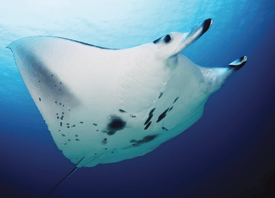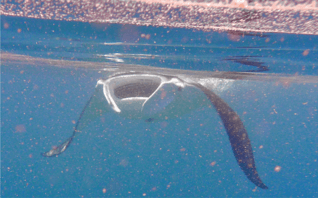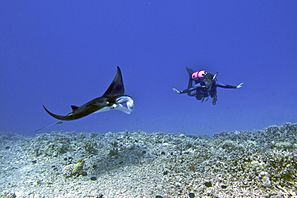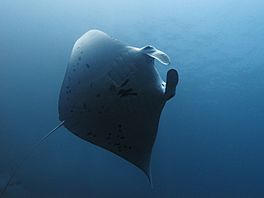Reef manta ray facts for kids
Quick facts for kids Reef manta ray |
|
|---|---|
 |
|
| M. alfredi in the Maldives | |
| Conservation status | |
| Scientific classification | |
| Genus: |
Mobula
|
| Species: |
alfredi
|
| Synonyms | |
|
Manta alfredi |
|
The reef manta ray (Mobula alfredi) is a type of ray. It belongs to the family Mobulidae. This ray is one of the biggest rays in the world. It is the second largest ray known, after the giant oceanic manta ray.
This species was first described in 1868 by Gerard Krefft. He was the director of the Australian Museum. He named it M. alfredi to honor Alfred, Duke of Edinburgh. Alfred was the first member of the British royal family to visit Australia. It was first placed in the Manta group. But in 2017, all mantas were moved into the Mobula group.
Reef manta rays usually have a disc width of about 3 to 3.5 meters (10 to 11.5 feet). They can grow up to 5.5 meters (18 feet) wide. For a long time, people thought it was the same as the oceanic manta ray. But in 2009, scientists confirmed it was a separate species. The reef manta ray lives in warm tropical and subtropical waters. You can find it in the Indo-Pacific Ocean. It prefers shallower, coastal areas. Sometimes, these rays travel short distances.
Contents
About the Reef Manta Ray
The reef manta ray can grow up to 5 meters (16.4 feet) wide. But they are usually 3 to 3.5 meters (10 to 11.5 feet) wide. Their body is flat from top to bottom. They have large, triangle-shaped pectoral fins on each side.
At the front of their head, they have two special fins called cephalic fins. These fins are extensions of their pectoral fins. They can roll them up like a spiral when swimming. Or they can spread them out to guide water into their large mouth when they eat. Their eyes and spiracles are on the sides of their head. The five gill slits are on their belly side.
They have a small fin on their back. Their tail is long and thin like a whip. Unlike some other rays, the manta ray does not have a spiny tail. Its back is dark black or deep blue. It has some white and grey areas on its head. Its belly is white. It might have dark spots or blotches. These markings can help scientists tell individual rays apart.
How to Tell Manta Rays Apart
The giant oceanic manta ray looks a lot like the reef manta ray. They live in some of the same places, so it can be confusing. But there are ways to tell them apart.
One difference is size. The oceanic manta ray is usually bigger. It averages 4 to 5 meters (13 to 16.4 feet) wide. The reef manta ray averages 3 to 3.5 meters (10 to 11.5 feet) wide. But young rays can be hard to tell apart by size alone.
The best way to tell them apart is by their color patterns. The reef manta ray has a dark back. It usually has two lighter areas on its head. These areas look like a soft fade from its dark back to whitish or grey. The line between these two lighter areas forms a "Y" shape.
The oceanic manta ray has a very dark back. Its two white areas are very clear, with no fading. The line between these white areas forms a "T" shape.
Their bellies also look different. The reef manta ray has a white belly. It often has spots between its gill slits. It also has spots near the edges of its pectoral fins and belly area. The oceanic manta ray also has a white belly. But its spots are usually grouped around its lower belly. Its cephalic fins, inside of its mouth, and gill slits are often black.
Where Reef Manta Rays Live
The reef manta ray lives in many warm parts of the Indo-Pacific Ocean. You can find them in places like Hawaii, Fiji, French Polynesia, Micronesia, Bali, Komodo, Maldives, Mozambique, Australia, and the Philippines. They mostly live near coasts.
Reef manta rays live in a wide area. They might travel short distances to follow their food, which is tiny sea creatures called zooplankton. They tend to stay in certain areas for cleaning and feeding. These areas are usually close to coasts, reefs, or islands.
Reef Manta Ray Life Cycle
The reef manta ray lives in the open ocean, which is called the pelagic zone. They eat by filtering water to catch zooplankton. Scientists believe mantas can live for at least 50 years.
Reef manta rays give birth to live young. This is called ovoviviparous. After mating, the fertilized eggs grow inside the female's body. At first, they are in an egg case. The baby ray eats the yolk. After the egg hatches, the baby stays inside the mother. It gets food from a milky liquid. The baby ray does not have a placenta like humans. It uses buccal pumping to get oxygen.
Usually, only one baby is born at a time. Sometimes, two babies develop. The pregnancy period is thought to be 12 to 13 months. When the baby is ready, it is about 1.4 meters (4.6 feet) wide. It weighs about 9 kilograms (20 pounds). It looks like a small adult. The mother usually gives birth near the coast. The young ray stays in shallow water for a few years while it grows.
Dangers to Reef Manta Rays
Natural Predators
Because reef manta rays are so big and can swim fast (up to 24 km/h or 15 mph), they have few natural enemies. Only large sharks like the tiger shark, great hammerhead shark, or bull shark are known to hunt them. Also, large marine mammals like the false killer whale and killer whale might attack them. Sometimes, a manta ray escapes an attack but loses part of a fin.
Human Dangers
The reef manta ray is listed as vulnerable by the IUCN. This means their numbers have dropped a lot in the last 20 years. This is mainly because of too much fishing.
Manta rays do not have many babies. They have a long pregnancy and usually only one pup. They also mature late. This means their population cannot recover quickly from fishing. In recent years, fishing for manta rays has increased. This is because their gill rakers are sold for traditional Chinese medicine. People believe these gill rakers have healing powers, but there is no scientific proof. This belief and clever marketing create a lot of demand.
-
M. alfredi at a cleaning station. It stays still while cleaner fish clean it.
-
M. alfredi from Yap, Micronesia.
Images for kids
-
M. alfredi communities in the Maldives
See also
 In Spanish: Manta alfredi para niños
In Spanish: Manta alfredi para niños










